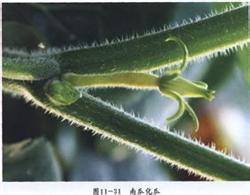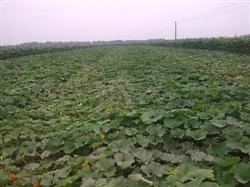Six key points of pumpkin cultivation techniques in small arch shed in early spring

Western pumpkin commonly known as small red pumpkin, small golden melon, belongs to the family Cucurbitaceae. Because of its high starch content, sweet noodles, powdered meat and excellent flavor, it belongs to the fine products of pumpkin. Western pumpkin is particularly rich in vitamins A, C and E, so it has a good role in medical and health care. In recent years, with the arrival of the era of aging population and the enhancement of people's awareness of health care, consumers' demand for pumpkin is increasing year by year. According to the survey, the mu income of planting pumpkin is about 2000 yuan. Next, the high-yield cultivation techniques of pumpkin in small arch shed in early spring are introduced for growers' reference. First, choose the superior species. Varieties with good quality, beautiful appearance, bright skin color, sweet taste and neat melon shape should be selected. Such as Dongsheng, Jinhongsheng and other varieties cultivated by Taiwan Nongyou Company. Second, soil preparation and fertilization. The planting land should choose the soil with rich and deep soil layer, loose texture, good air permeability and convenient drainage and irrigation. In the spring ploughing in the middle of March, 1000 kg of rotten dried chicken manure and 50 kg of ternary compound fertilizer of nitrogen, phosphorus and potassium were applied per mu. Third, planting at the right time. The plow fine soil blocks were made into planting beds, the width of short vines was 0.6 meters, the width of plastic film was 0.8 meters, the width of long vines was 0.8 meters, and the width of plastic film was 1.0 meters. The planting density of long vines is 750-850 plants, the row spacing is 1.8 meters, the plant spacing is 0.45-0.50 meters, and the planting density of short vines is 1300-1500 plants, the row spacing is 1 meter, and the plant spacing is 0.45-0.50 meters. Then the burrowing machine is used to press the holes, cover the plastic film, and compact both sides of the film with soil. The planting time is sunny for several consecutive days from late March to early April, and the daily average temperature is above 15 ℃. The seedlings were taken and planted with broken membrane, compacted with soil around the seedling pit, watered with planting, and finally arched bamboo pole, covered with arch film, stretched and pressed. Fourth, field management. The suitable temperature in vegetative growth period is 20: 25 ℃, and in flowering and fruiting stage is 25: 27 ℃. Too high or too low temperature is not conducive to growth. When the temperature in the arch shed is higher than 28 ℃ at noon, ventilation can be carried out. The method of double-vine pruning should be adopted for the varieties of long vines, while those of short vines should be allowed to grow. The long vine variety has 1 melon per vine, 7 leaves and 9 leaves, and all melons before 7 leaves are removed. The first melon brought out by the short vine variety must be removed, and then 2 melons are left per plant. There are generally bee sources, and there is no need for manual pollination in good weather with wind pollination. Otherwise, artificial pollination should be assisted. When there is no dew in the sunny morning, remove the male flowers, remove the petals, and gently apply the anther to the female flower stigma, 1 male flower to 2 female flowers. Cover the female flowers with male flowers or leaves after pollination to prevent Rain Water. When the melon sits down and has the size of goose eggs, about 30 grams of compound fertilizer is applied to each plant. When the melon grows to 0.5 kg, the second fertilizer can be applied according to the soil fertility, and when the drought weather is encountered, it can be watered twice in the vine extension period and fruit expansion period. When the melon turns red gradually from yellow, turn the melon 120 degrees for the first time, and turn again after 5-7 days. When turning the melon, combine the cushion melon to make the melon body in the sunny position as far as possible. Fifth, prevention and control of diseases and insect pests. Pumpkin grows healthily, and there are few diseases in the whole growth period. When melon aphid occurs, 2.5% kungfu EC 2000 times can be used, and mites can be sprayed with avermectin 2000 times. The main diseases should have virus disease and powdery mildew, powdery mildew can be treated with 75% chlorothalonil, virus disease can be treated with Shenxie 500x liquid, and bacterial leaf spot can be controlled with 72% agricultural streptomycin 3000 times. (6) timely harvest. Pumpkins should be harvested in time after ripening to prevent future fruit setting from being affected. Generally speaking, the first batch of products can be harvested after 60 days of planting. Mature commercial melons are thick, flat and round, orange-red, and glossy with wax powder. When picking melons, you can use scissors to harvest, leaving the handle 2 cm to 3 cm.
- Prev

How to prevent pumpkin spot disease
Cucurbita mottle mainly affects leaves and flower axes. The pathogen overwinters in the soil with the diseased body. In spring, the pathogen spread by rain sputtering, and the leaf spots were round to nearly round or amorphous in the early stage of the disease. The leaf margin is black brown, the junction of disease and health is moist, when the humidity is high, the spot surface is densely populated with small black spots, and the serious leaf spot is fused, causing the leaf bureau to be wet.
- Next

Key techniques of planting autumn pumpkin
Pumpkin has strong root system, deep and wide distribution, strong stress resistance and strong ability to absorb water and nutrients. When pumpkin is cultivated in greenhouse soil with high fertility, the stems and leaves are often too luxuriant, which often leads to falling flowers and fruits, and the yield is not high. Therefore, in the cultivation of pumpkin in the arch shed, we must strengthen management, proper close planting, control.
Related
- Where is it suitable to grow horseradish in China? it is expected to see the middle altitude horseradish in Alishan.
- How to prevent tomato virus disease reasonably? (Control methods included)
- Many people like to plant towel gourd on the balcony. What are the main points of this method and management?
- What crops can chili peppers be mixed with?
- Fertilization techniques and matters needing attention in Tomato
- What are the grafting techniques for peach seedlings in spring?
- Harm and control methods of root swelling disease of Chinese cabbage
- What are the pests of sweet potatoes? How to prevent and cure it?
- Symptoms, causes and Control methods of navel Rot in Tomato
- The cause of "Cucumber rotten bibcock" in Farmers' planting Cucumber and its Control Plan

